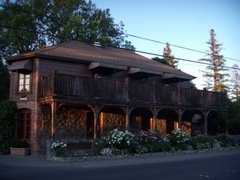I have a bit of an obsession with roasts and as a result, I am always trying different ways and means to inject flavour and texture into the roasts I make. I discovered the technique of brining about a year ago, and it proved so successful that I now brine all the poultry I roast.
Yesterday, I decided to make a pork roast. I have always found pork a tough one to cook with dry heat, because it tends to dry out easily if overdone, and yet cannot be underdone because of the salmonella risk. The meat when sliced, should be juicy with just a faint pink blush (squemish types might want to cook it longer until there is no pink, but that to me is overcooking). In addition, pork on its own is quite a plain meat (unlike beef or lamb) and so needs heaps of seasoning. Getting that seasoning to permeate deep into a large roast is quite difficult.
I had never tried brining pork before, but on the advice of the chefs at the CIA, I decided to give it a go. I find the loin quite dry (unless it is kurobuta pork!), so I decided to use pork belly instead. I got a well marbled slab of belly with with rind and ribs attached, but sliced the bones off for another use (bbq ribs anyone?). I like my pork roast with the rind on, because I love crunchy pork crackling. I did wonder if the brining would affect the way the skin crackles up, but decided to proceed with my experiment anyway.
I mixed about 700ml of apple cider with 120g of salt, 2 bay leaves, 3 cloves of crushed garlic, one sliced shallot and some fresh sage. I then left the pork in to brine for about 5 hours. After 5 hours, I removed the pork from the brine, scored the rind in 1 1/2 in intervals, and placed the pork on a rack in the sink to drain, then poured boiling water on the rind. This supposedly tightens the rind and exposes the fat underneath, enabling the rind to crackle easier.
I left the pork to dry off for a half hour, then placed it into a 220 deg c oven for about 20 mins, then turned the temperature down to 120 deg c and let it cook for the next hour and a half. (The roast must have weighed around 1.3 kg or so).
I was disappointed that the skin did not crackle properly, and this I attribute (correctly or otherwise) to the brining process. The meat however, was wonderfully flavoured, much better than the other pork roasts I have made in the past, and tenderised just right by the acid in the brine.

I served up the roast on a bed of caramalized onions (deglazed with the same apple cider for consistency), baby asparagus with a shallot-balsamic vinegarette, mashed potatoes, and sauces of pan jus and buttered applesauce. The meal was hearty and delicious.
While I was pretty happy with the results, It would have been even better to be able to get the skin to crackle even with the brining. Back to the drawing board I guess...
 I served up the roast on a bed of caramalized onions (deglazed with the same apple cider for consistency), baby asparagus with a shallot-balsamic vinegarette, mashed potatoes, and sauces of pan jus and buttered applesauce. The meal was hearty and delicious.
I served up the roast on a bed of caramalized onions (deglazed with the same apple cider for consistency), baby asparagus with a shallot-balsamic vinegarette, mashed potatoes, and sauces of pan jus and buttered applesauce. The meal was hearty and delicious.

 Italian Almond Biscotti (makes 48)
Italian Almond Biscotti (makes 48)
 With the legs, I decided rather ambitously to attempt confit du canard. Now, my best ever encounter with this dish was back in 2004, in a tiny little country bistro in the town of Moret-sur-Loing. I don't even remember the name of the bistro, but all I can say is that the confit was the most delicious, the most melt-in-your-mouth-tender, the absolute BEST confit one can possibly imagine. It was so heartbreakingly good, I have been afraid to order confit ever since at any other restaurant.
With the legs, I decided rather ambitously to attempt confit du canard. Now, my best ever encounter with this dish was back in 2004, in a tiny little country bistro in the town of Moret-sur-Loing. I don't even remember the name of the bistro, but all I can say is that the confit was the most delicious, the most melt-in-your-mouth-tender, the absolute BEST confit one can possibly imagine. It was so heartbreakingly good, I have been afraid to order confit ever since at any other restaurant.



